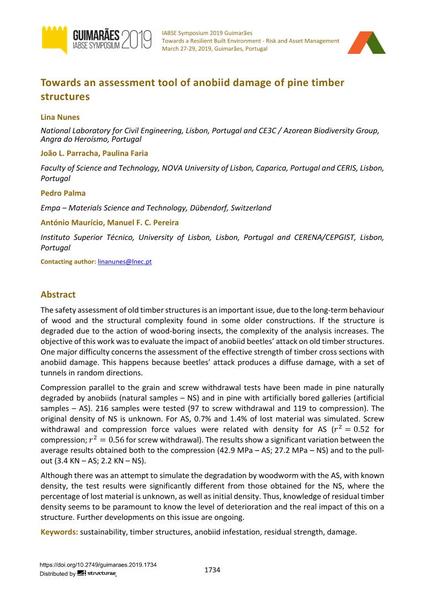Towards an assessment tool of anobiid damage of pine timber structures

|
|
|||||||||||
Détails bibliographiques
| Auteur(s): |
Lina Nunes
(National Laboratory for Civil Engineering, Lisbon, Portugal and CE3C / Azorean Biodiversity Group, Angra do Heroísmo, Portugal)
João L. Parracha (Faculty of Science and Technology, NOVA University of Lisbon, Caparica, Portugal and CERIS, Lisbon, Portugal) Paulina Faria (Faculty of Science and Technology, NOVA University of Lisbon, Caparica, Portugal and CERIS, Lisbon, Portugal) Pedro Palma (Empa – Materials Science and Technology, Dübendorf, Switzerland) António Maurício (Instituto Superior Técnico, University of Lisbon, Lisbon, Portugal and CERENA/CEPGIST, Lisbon, Portugal) Manuel F. C. Pereira (Instituto Superior Técnico, University of Lisbon, Lisbon, Portugal and CERENA/CEPGIST, Lisbon, Portugal) |
||||
|---|---|---|---|---|---|
| Médium: | papier de conférence | ||||
| Langue(s): | anglais | ||||
| Conférence: | IABSE Symposium: Towards a Resilient Built Environment Risk and Asset Management, Guimarães, Portugal, 27-29 March 2019 | ||||
| Publié dans: | IABSE Symposium Guimarães 2019 | ||||
|
|||||
| Page(s): | 1734-1741 | ||||
| Nombre total de pages (du PDF): | 8 | ||||
| DOI: | 10.2749/guimaraes.2019.1734 | ||||
| Abstrait: |
The safety assessment of old timber structures is an important issue, due to the long-term behaviour of wood and the structural complexity found in some older constructions. If the structure is degraded due to the action of wood-boring insects, the complexity of the analysis increases. The objective of this work was to evaluate the impact of anobiid beetles’ attack on old timber structures. One major difficulty concerns the assessment of the effective strength of timber cross sections with anobiid damage. This happens because beetles’ attack produces a diffuse damage, with a set of tunnels in random directions. Compression parallel to the grain and screw withdrawal tests have been made in pine naturally degraded by anobiids (natural samples – NS) and in pine with artificially bored galleries (artificial samples – AS). 216 samples were tested (97 to screw withdrawal and 119 to compression). The original density of NS is unknown. For AS, 0.7% and 1.4% of lost material was simulated. Screw withdrawal and compression force values were related with density for AS (𝑟2 = 0.52 for compression; 𝑟2 = 0.56 for screw withdrawal). The results show a significant variation between the average results obtained both to the compression (42.9 MPa – AS; 27.2 MPa – NS) and to the pull- out (3.4 KN – AS; 2.2 KN – NS). Although there was an attempt to simulate the degradation by woodworm with the AS, with known density, the test results were significantly different from those obtained for the NS, where the percentage of lost material is unknown, as well as initial density. Thus, knowledge of residual timber density seems to be paramount to know the level of deterioration and the real impact of this on a structure. Further developments on this issue are ongoing. |
||||
